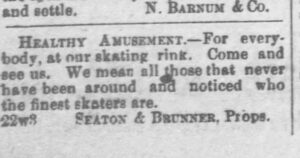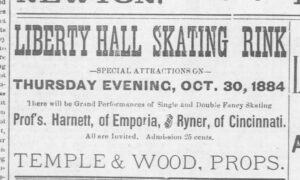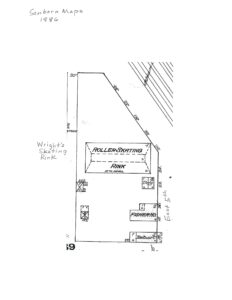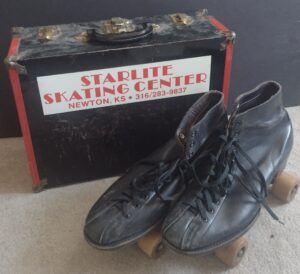by Kristine Schmucker, HCHM Archivist/Curator
“Allow me to give you a few facts regarding the skating rink craze, which is becoming more and more violent and disgusting.” (Newton Kansan, 26 February 1885)
With this opening the editor of the Newton Kansan expressed his dismay at this past time that was “one of the most widespread and harmful phases of dissipation we have yet to meet.”
“Most Widespread and Harmful Phases of Dissipation”
The Kansan editor quotes a pastor writing to the editor of the U.W. Advocate who reported of young ladies “near death’s door” because of time spent at the roller rink. One young lady implored her pastor “O, don’t cease to cry out against the rink, that is what brought me to this!” According to the article there were reports of deaths “through the rink.” In addition, the craze was keeping young people from attending Thursday evening prayer meetings at church. Men were not able to pay their debts “because of money expended at the rinks” and families were broken up.
The rinks expose people to “over-exertion; accidents occur in the form of broken arms . . .there is doubtless always a class of present to see ladies fall, and the gentlemen fall over them.” They are expensive and often had side shows with opportunities for “indiscretion, the first steps toward vice there is no parental supervision.” Even secular newspapers like the New York Tribune and Sun declare the rink as “an evil . . . worse than the ordinary theatre.”
The article concludes with three points against skating rinks 1) an antagonist of church, 2) demoralizes and undermines character, 3) destroys health. (Newton Kansan 26 February 1885)
“Immoral Effects”
Another writer wondered in 1884:
“Does it improve a young girl’s modesty or morals to fall in a heap on a skating rink floor, in the gaze of hundreds, with perhaps her feet in the air and her clothes tossed over her head? Is it good for her proper training to see other females in such plight?”
The editorial concluded by claiming that roller skating could not “help having immoral effects” even if the management of the rink was sound. The long-ago writer also claimed that roller skating was the “most mischievous form of public amusement ever introduced” and believed that it would soon be “suppressed as a dangerous evil.”
The editorial staff of the Lowell, MA paper expressed dismay at the way skaters were “enthusiastically, hurling themselves across the floor.” They also lamented that the local rink was “the cause of more and worse immorality […] in the city than even music halls. multi-purpose facilities, playing host to dances, meetings, and other community events.”
“Preacher’s Occupation”
A short article in the Newton Kansan, author unidentified, pushed back at these negative voices noting, “were there no dangers to menace the soul, the preacher’s occupation would be gone . . .just as a subject was on the point of exhaustion . . . instantly the church finds a new target to practice on.” (Newton Kansan, 12 March 1885)
Other than concerned preachers, roller skating was deemed an appropriate activity for men and women to do together in the 1880s- 1910, allowing young couples to meet without reprisal or rigid chaperoning. Most of the early marketing included the health benefits of roller skating.
Roller Skating in Newton: “Fun for Every Lover of Innocent Amusement.”
Roller skating was a popular pastime in Newton with at least three skating rinks in operation from 1882 – 1890. Halstead also had a skating rink in 1884 managed by Gus H Otto. (Newton Kansan 18 December 1884)
On December 14, 1882, Henry Brunner and George W. Seaton purchased the Chamber Bros skating rink which was under construction on W 6th street, opposite the Presbyterian Church. At times this skating rink was referred to as the Parlor skating rink, the Eagle Hall Skating Rink, the Seaton & Brunner.
“A Grand Time is Expected:” Seaton & Brunner Rink
The skating rinks were more than skating, they also served as a community center and were used for a variety of activities. December 20, Seaton & Brunner announced that they would need to delay their next masquerade skating until January 1, 1884. They promised that the doors would be opened as usual, “the bank will be on the streets, which everybody follows to the rink and there have fun and grow fat.”
In February 1884, the theme at the Eagle Hall Skating Rink was a masque carnival featuring colonial dress. Prizes awarded for best costume and only 25 cents for admission. “A grand time is expected.” In the May 10, 1883 Kansan, people were invited to attend a ball hosted by the Newton Cornet Band, noting it “will be one of the grandest of the season.” On July 2, 1883, participants were promised “lots of fun for every lover of innocent amusement.” As part of these events contests were sometimes held. In February 1883, Fred Durcher was awarded the best man or boy skater and Flora Bassett the best lady.
The proprietors of the Parlor rink also engaged the services of J. Steward Hunell, professor of roller skating, to teach those interested in “this most healthful exercise with special attention given to the ladies and children at the afternoon session.”
In 1884, the Eagle/Parlor/Seaton & Brunner Skating Rink enjoyed enough popularity it expanded with an additional 6 feet on each side with a 40 foot addition and a hard maple floor, making it “one of the largest rinks in the state.”
Liberty Skating Rink
A second skating rink located in Newton in 1884 was known as the Liberty Hall. Little reference can be found in the newspapers to this establishment. They also had professors of roller skating teach roller skating.
“The Biggest Political Meeting:” Wright’s Rink
The other long running and popular skating rink was owned and operated by George Z. Wright. He opened Wright’s Rink, sometimes known as Wright’s Opera house, in 1885-1886 on E 5th.
Like Seaton & Brunner’s, Wright’s served as more than a skating rink as it was the meeting place for many important community meetings.
Wright’s hosted the county convention in August 1888. On September 20, 1888, Hon. Samuel B. Peters, Kansas Representative, spoke at Wright’s Opera house on “the political issues of the day . . .good music will be in attendance. The ladies are especially invited.” (Newton Kansan, 20 September 1888). In October 1888, “the biggest political meeting of the year was held” at Wright’s. A joint debate between Hon. J. W. Ady and Hon. Cyrus Corning, with two moderators, one for each party and a referee with “careful arrangements concerning the seating of the audience, so that each party may receive fair treatment.”
Dr. J.F. Hilts gave “what he called a spiritual entertainment” at Wright’s in November 1885. Although well attended, the editor of the Newton Kansan was not impressed with Dr. Hilts performance, noting it “was a slim affair . . . he didn’t give them much.” In 1887, a sparring match between Thomas McLain and Frank McClintic, both local men, was hosted at Wright’s. Other events included plays and balls.
One wonders how much time there was for actual roller skating.
Things changed and roller skating lost some of it’s popularity. By 1901, Newton Steam Laundry was located in the building.
Roller Skating
Roller skating has enjoyed popularity at different times over history. The activity originated in the performing arts in the 18th century and was first used on stage in a 1743 theater production.
It boomed in popularity again in 1880-1910. The 1930s-50s saw another revival of interest and another in the 1970s & 80s.
Many probably remember the Starlight Roller Rink located on E 3rd, Newton, Ks. These photos are from a Girl Scouts’ event in March 1987.
What favorite memories do you have of roller skating? Share on our Facebook page!
Sources
- Newton Kansan 14 December 1882, 26 December 1882, 1 February 1883, 8 March 1883, 28 June 1883, 4 September 1884, 30 October 1884, 12 November 1885.
- The History Behind the Roller Skating Trend – JSTOR Daily accessed 01/19/2024.
- From Ballrooms to Discos, Tracking 150 Years of Roller Rinks – Curbed accessed 01/19/2024
- The Controversial First Days of Roller Skating Rinks, Lowell – 1885 – Forgotten New England accessed 01/19/20024







